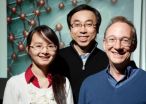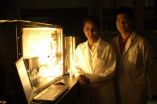(Press-News.org) UCSF researchers have developed a new approach to decoding the vast information embedded in an organism's genome, while shedding light on exactly how cells interpret their genetic material to create RNA messages and launch new processes in the cell.
By combining biochemical techniques with new, fast DNA-sequencing technology and advanced computer technology, the team was able to examine with unprecedented resolution how a cell converts DNA into RNA – a molecular cousin of DNA that is used in the process of creating proteins that govern most biological functions. And they did so within the cell itself, rather than in a test tube.
As a result, they were able to bridge an important gap in the understanding of what causes genes to be turned on and off. Their findings will appear in the Jan. 20 issue of the journal Nature and online at www.nature.com.
The main way the genome is "read" in a cell is through its transcription into RNA, the researchers explained. Until now, scientists have been able to detect which RNAs were produced, but have had a limited view of how much of the genome was being decoded, or "transcribed," or what controls how fast these RNAs are made. The new technique enables them to watch this process directly.
"This lets you capture the cell in the process of turning the DNA into RNA at unprecedented resolution," said Jonathan S. Weissman, PhD, a professor in the UCSF Department of Cellular and Molecular Pharmacology and senior author on the paper. "Before, we were typically studying the end product. Now, we can directly watch how these RNA messages are produced in vivo."
The advance enables researchers to make sense of the vast amounts of data generated by the Human Genome Project and the multiple genome sequencing efforts worldwide, while providing new tools for studying basic processes like the reprogramming of stem cells, Weissman said.
"The genome is the hard drive of the cell," explained L. Stirling Churchman, PhD, who was the first author of the two-author paper and last year was honored for this work with the Dale F. Frey for Breakthrough Scientists award of the Damon Runyon Cancer Research Foundation. "Until now, we've been able to see the information that the hard drive contains as well as see the result after the cell has read that information, but we didn't know which precise data it was accessing.
"Here, we've been able to see which data it is accessing, with a high enough resolution to also be able to see how it's actually working," she said.
Until quite recently, many scientists thought that less than 5 percent of the human genome was actually transcribed into RNA and therefore used in the cell's function, Churchman said. Recent advances in the field have revealed a tremendous complexity in that process, with new understanding that the majority of DNA is transcribed. Much of the product is still considered "junk RNA" – simply a byproduct of the process.
"Now, the question is not, 'Why is that DNA there?' but, 'Why is that RNA there?'" said Churchman, a physicist and post-doctoral scholar at UCSF. "It could be junk RNA, but we don't know."
The research focused on DNA transcription in baker's yeast, largely because that organism's genome has been extensively studied. As a result, previous scientists had already developed maps of the genome and identified the positions of nucleosomes along it. Nucleosomes are grape-like structures formed by strands of DNA wrapped like vines around histone proteins, and serve to organize enormously long DNA molecules.
Histone proteins are known to have many marks that dictate whether a gene should be turned on or off, among other functions, while retaining a history of what has happened
recently in that part of the gene code and a "plan" for what should happen in the future.
By overlaying those maps with their own maps of RNA production, the scientists were able to observe for the first time that polymerase comes in direct contact with the histone proteins during the transcription process, while also seeing how the nucleosomes acted as a speed bump for the polymerase enzyme as it moved along the genome transcribing DNA into RNA. In addition, the research showed that the organization of histone marks controlled whether "junk RNA" was produced from a given region of DNA.
This new approach gives researchers a precise view of the process in action, as well as insights on general trends in how histone proteins and their marks affect transcription.
"There is a long history of trying to look at how genes are turned on," Weissman said. "So far, nothing has been analogous at this resolution and depth."
INFORMATION:
The research was supported by the Damon Runyon Cancer Research Foundation and by the Howard Hughes Medical Institute. The authors declare no conflicts of interest.
Churchman and Weissman were the sole co-authors on the paper. Both are affiliated with the UCSF Department of Cellular and Molecular Pharmacology and the California Institute for Quantitative Biosciences, at UCSF. Weissman is also an investigator with the Howard Hughes Medical Institute.
UCSF is a leading university dedicated to promoting health worldwide through advanced biomedical research, graduate-level education in the life sciences and health professions, and excellence in patient care.
Follow UCSF on Twitter @ucsf/@ucsfscience
UCSF team views genome as it turns on and off inside cells
2011-01-20
ELSE PRESS RELEASES FROM THIS DATE:
The Orion nebula: Still full of surprises
2011-01-20
The Orion Nebula, also known as Messier 42, is one of the most easily recognisable and best-studied celestial objects. It is a huge complex of gas and dust where massive stars are forming and is the closest such region to the Earth. The glowing gas is so bright that it can be seen with the unaided eye and is a fascinating sight through a telescope. Despite its familiarity and closeness there is still much to learn about this stellar nursery. It was only in 2007, for instance, that the nebula was shown to be closer to us than previously thought: 1350 light-years, rather ...
Cancer scientists discover genetic diversity in leukemic propagating cells
2011-01-20
(Toronto, Canada – January 20, 2011) – Cancer scientists led by Dr. John Dick at the Ontario Cancer Institute (OCI) and collaborators at St Jude Children's Research Hospital (Memphis) have found that defective genes and the individual leukemia cells that carry them are organized in a more complex way than previously thought.
The findings, published today in Nature (DOI:10.1038/nature09733), challenge the conventional scientific view that cancer progresses as a linear series of genetic events and that all the cells in a tumour share the same genetic abnormalities and ...
How much sex is enough?
2011-01-20
Society has long debated the contrasting advantages of monogamy and promiscuity and, in western society at least, the long term benefits of monogamy have in general won out. However new research published in BioMed Central's open access journal BMC Evolutionary Biology shows that sperm from polygamous mice are better competitors in the race for fertilisation.
Dr Renée Firman at the Centre for Evolutionary Biology, University of Western Australia, has used house mice to show that sperm from rival males compete to fertilise females and that, over several generations, polygamy ...
Creating simplicity: How music fools the ear
2011-01-20
What makes music beautiful? The best compositions transcend culture and time – but what is the commonality which underscores their appeal? New research published in BioMed Central's open access journal BMC Research Notes suggests that the brain simplifies complex patterns, much in the same way that 'lossless' music compression formats reduce audio files, by removing redundant data and identifying patterns.
There is a long held theory that the subconscious mind can recognise patterns within complex data and that we are hardwired to find simple patterns pleasurable. Dr ...
Quality improvement intervention for ICUs results in increased use of evidence-based care practices
2011-01-20
A multifaceted quality improvement intervention that included education, reminders and feedback through a collaborative telecommunication network improved the adoption of evidenced-based care practices in intensive care units at community hospitals for practices such as preventing catheter-related bloodstream infections and ventilator-associated pneumonia, according to a study that will appear in the January 26 issue of JAMA. The study is being published early online to coincide with its presentation at the annual meeting of the Society of Critical Care Medicine.
Despite ...
Triblock spheres provide a simple path to complex structures
2011-01-20
CHAMPAIGN, Ill. — University of Illinois materials scientists have developed a simple, generalizable technique to fabricate complex structures that assemble themselves.
Their advance, published in the Jan. 20 issue of Nature, utilizes a new class of self-assembling materials that they developed. The team demonstrated that they can produce a large, complex structure – an intricate lattice – from tiny colloidal particles called triblock Janus spheres.
"This is a big step forward in showing how to make non-trivial, non-obvious structures from a very simple thing," said ...
Survey reveals potential innovation gap in the US
2011-01-20
Cambridge, Mass., January 19, 2011 – Invention and innovation are essential to remaining globally competitive, and a new survey shows an untapped group of potential inventors in the U.S. The 2011 Lemelson-MIT Invention Index , announced today, indicates that American women ages 16 – 25 possess many characteristics necessary to become inventors, such as creativity, interest in science and math, desire to develop altruistic inventions, and preference for working in groups or with mentors – yet they still do not see themselves as inventive. Young men in the same age group ...
Parental divorce linked to suicidal thoughts
2011-01-20
TORONTO, ON –Adult children of divorce are more likely to have seriously considered suicide than their peers from intact families, suggests new research from the University of Toronto
In a paper published online this week in the journal Psychiatry Research, investigators examined gender specific differences among a sample of 6,647 adults, of whom 695 had experienced parental divorce before the age of 18. The study found that men from divorced families had more than three times the odds of suicidal ideation in comparison to men whose parents had not divorced. Adult daughters ...
Case Western Reserve and Athersys show regenerative benefit of MultiStem after spinal cord injury
2011-01-20
Case Western Reserve University School of Medicine and Athersys, Inc. (NASDAQ: ATHX) announced a joint scientific study on spinal cord injury will be published today in the January issue of the Journal of Neuroscience. The study, by leading researchers from the Department of Neurosciences at the School of Medicine and scientists at Athersys, presents data supporting the potential therapeutic benefit of Athersys' MultiStem® program for spinal cord injury. Researchers observed that administration of Multipotent Adult Progenitor Cells (MAPC) following spinal cord injury in ...
New reactor paves the way for efficiently producing fuel from sunlight
2011-01-20
PASADENA, Calif.—Using a common metal most famously found in self-cleaning ovens, Sossina Haile hopes to change our energy future. The metal is cerium oxide—or ceria—and it is the centerpiece of a promising new technology developed by Haile and her colleagues that concentrates solar energy and uses it to efficiently convert carbon dioxide and water into fuels.
Solar energy has long been touted as the solution to our energy woes, but while it is plentiful and free, it can't be bottled up and transported from sunny locations to the drearier—but more energy-hungry—parts ...



